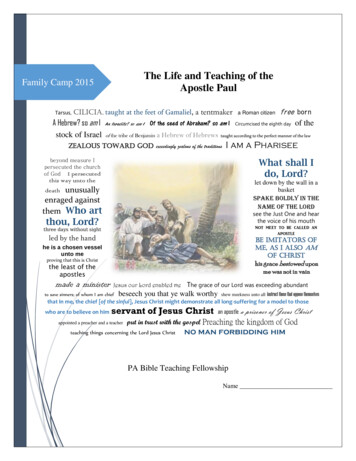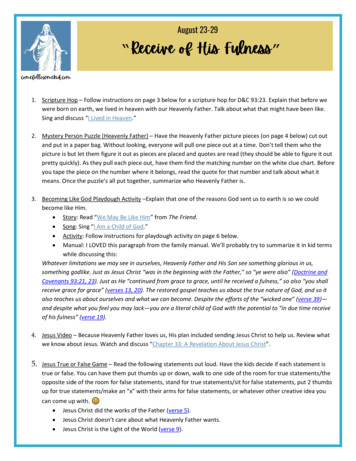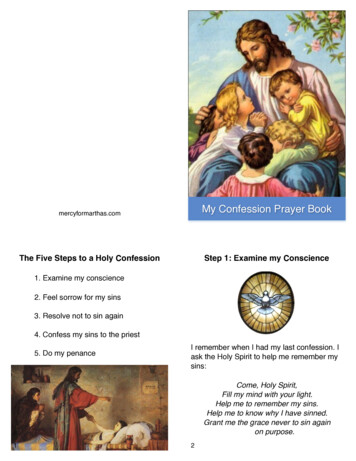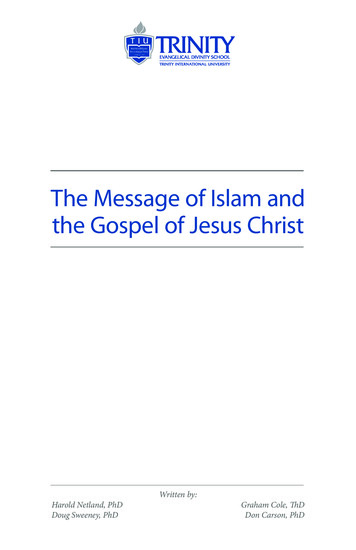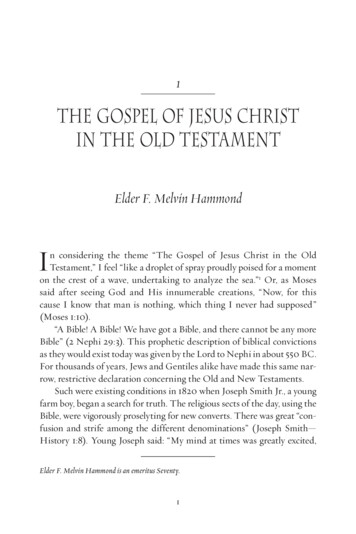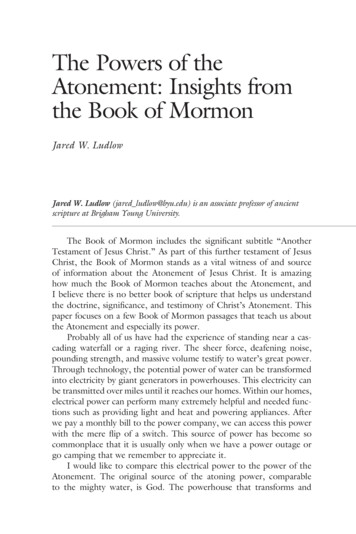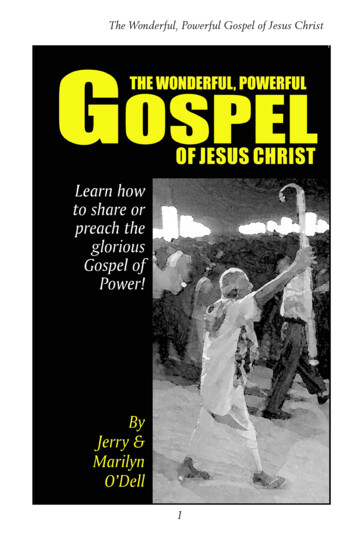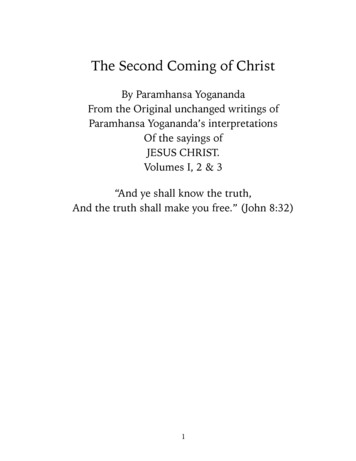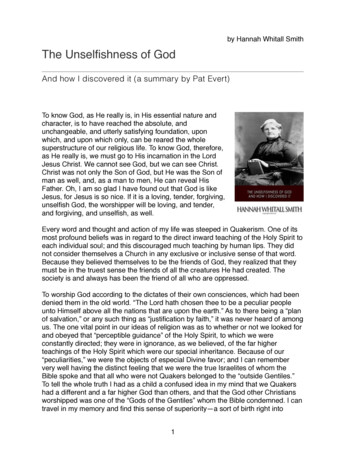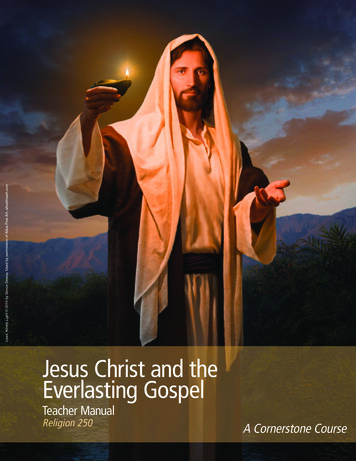
Transcription
Jesus Christ and the Everlasting GospelTeacher ManualReligion 250Published byThe Church of Jesus Christ of Latter-day SaintsSalt Lake City, Utah
Comments and corrections are appreciated. Please send them, including errors, to:Seminaries and Institutes of Religion Curriculum Services50 E. North Temple St., Floor 8Salt Lake City, Utah 84150-0008USAEmail: ces-manuals@ldschurch.orgPlease list your complete name, address, ward, and stake.Be sure to give the title of the manual. Then offer your comments. 2015 by Intellectual Reserve, Inc.All rights reserved.Printed in the United States of AmericaVersion 1, 6/15English approval: 8/14PD10052296
ContentsIntroduction to the Jesus Christ and the Everlasting Gospel Teacher Manual. . . . .v1Jesus Is the Living Christ . . . . . . . . . . . . . . . . . . . . . . . . . . . . . . . . 12Jesus Christ Is Central to All Human History3Jehovah and His Premortal Ministry . . . . . . . . . . . . . . . . . . . . . . . . . . 84Jehovah Created the Earth . . . . . . . . . . . . . . . . . . . . . . . . . . . . . . 115Jesus Christ Was Jehovah of the Old Testament . . . . . . . . . . . . . . . . . . 156Types, Shadows, and Symbols of Jesus the Christ . . . . . . . . . . . . . . . . . 197Jesus Christ—God’s Only Begotten Son in the Flesh . . . . . . . . . . . . . . . 228Jesus Christ Fulfilled All Righteousness . . . . . . . . . . . . . . . . . . . . . . . 269The Savior’s Profound Influence . . . . . . . . . . . . . . . . . . . . . . . . . . . 29. . . . . . . . . . . . . . . . . . . .410Come, Follow Me11Jesus Christ Went About Doing Good12Miracles on the Roads of Palestine13Jesus Christ Called Twelve Apostles . . . . . . . . . . . . . . . . . . . . . . . . . 4514Jesus Christ Is the Messiah . . . . . . . . . . . . . . . . . . . . . . . . . . . . . . 4915Jesus Christ Instituted the Sacrament . . . . . . . . . . . . . . . . . . . . . . . . 5316The Savior Atoned for the Sins of All Mankind17The Savior Suffered and Died on Calvary’s Cross . . . . . . . . . . . . . . . . . 6118The Savior Ministered in the Spirit World . . . . . . . . . . . . . . . . . . . . . . 6519He Is Risen . . . . . . . . . . . . . . . . . . . . . . . . . . . . . . . . . . . . . . . 6920The Savior Ministered to His “Other Sheep” . . . . . . . . . . . . . . . . . . . . 7421Jesus Christ Organized His Church . . . . . . . . . . . . . . . . . . . . . . . . . 7822The Father and the Son Appeared to Joseph Smith . . . . . . . . . . . . . . . . 8223The Savior Restored His Priesthood, Church, and Gospel24He Lives! . . . . . . . . . . . . . . . . . . . . . . . . . . . . . . . . . . . . . . . . 9025Jesus Christ Will One Day Return . . . . . . . . . . . . . . . . . . . . . . . . . . 9426Jesus Christ Will Rule as King of Kings and Judge the World27Jesus Christ Is the Light, Life, and Hope of the World28A Personal Witness of Jesus Christ . . . . . . . . . . . . . . . . . . . . . . . . . 107Handouts. . . . . . . . . . . . . . . . . . . . . . . . . . . . . . . . . . . 33. . . . . . . . . . . . . . . . . . . . . . . 37. . . . . . . . . . . . . . . . . . . . . . . . . 41. . . . . . . . . . . . . . . . . . 57. . . . . . . . . . . . 86. . . . . . . . . . 99. . . . . . . . . . . . . 103. . . . . . . . . . . . . . . . . . . . . . . . . . . . . . . . . . . . . . . . . . 111
Introduction to the Jesus Christ and theEverlasting Gospel Teacher Manual(Religion 250)What is expected of a religion teacher?As you prepare to teach, it is important to understand the Objective of Seminaries andInstitutes of Religion:“Our purpose is to help youth and young adults understand and rely on the teachings and Atonementof Jesus Christ, qualify for the blessings of the temple, and prepare themselves, their families, andothers for eternal life with their Father in Heaven” (Gospel Teaching and Learning: A Handbook forTeachers and Leaders in Seminaries and Institutes of Religion [2012], x).You can achieve this purpose by living the gospel, effectively teaching the gospel toyour students, and appropriately administering your class or program. As you prepareand teach the gospel in these ways, you will qualify for the influence of the HolyGhost.It is your opportunity to help students learn by the Spirit so they can strengthen theirfaith and deepen their conversion. You can help students accomplish this as you leadthem to identify, understand, feel the truth and importance of, and prepare to applysignificant doctrines and principles of the gospel of Jesus Christ.The Gospel Teaching and Learning handbook is an essential resource for understandingthe teaching process and how to become successful in the classroom. Refer often tothis handbook.What are the objectives of this course?This course, Jesus Christ and the Everlasting Gospel (Religion 250), gives students theopportunity to study the eternal ministry of Jesus Christ, focusing on His divine rolesthroughout His premortal, mortal, and postmortal life. The standard works, the wordsof modern prophets, and the document titled “The Living Christ: The Testimony of theApostles” (Ensign or Liahona, Apr. 2000, 2–3) are used as inspired resources for thiscourse. Elder Richard G. Scott of the Quorum of the Twelve Apostles has emphasizedthe importance of studying the life and mission of Jesus Christ:“I energetically encourage you to establish a personal study plan to better understandand appreciate the incomparable, eternal, infinite consequences of Jesus Christ’s perfectfulfillment of His divinely appointed calling as our Savior and Redeemer. Profoundpersonal pondering of the scriptures accompanied by searching, heartfelt prayer willfortify your understanding of and appreciation for His priceless Atonement” (“He Lives!All Glory to His Name!” Ensign or Liahona, May 2010, 77).As students come to understand and appreciate the significance of the Savior’s divinecalling and the impact He has in their lives, they will be fortified against life’schallenges and feel better prepared to discuss the divine roles of the Savior in the planof salvation, of which their personal lives are an integral part.v
INTRODUCTION TO THE JESUS CHRIST AND THE EVERLASTING GOSPEL TEACHER MANUALWhat is expected of students?Students should read the scripture passages and prophetic talks listed in the StudentReadings section of each lesson. Students should also meet attendance requirementsand demonstrate competency with course material.How are lessons structured in this manual?This course is designed as a semester-long course with 28 lessons written for50-minute class periods. If your class meets twice each week, teach one lesson eachclass period. If your class meets only once each week for 90 to 100 minutes, combineand teach two lessons each class period. Each lesson outline consists of four sections: Introduction Background Reading Suggestions for Teaching Student ReadingsIntroductionThis section provides a brief introduction to the topics and objectives of the lesson.Background ReadingThis section recommends resources, such as messages from modern prophets, that canhelp you better understand the doctrines, principles, and gospel truths covered in thelesson outline.Suggestions for TeachingThe Suggestions for Teaching section includes material to help you know both what toteach and how to teach it (see also sections 4.3.3 and 4.3.4 in the Gospel Teaching andLearning handbook). The suggested learning activities are designed to help studentsidentify, understand, and apply sacred truths. You may choose to use some or all of thesuggestions as you adapt them to fit your individual teaching style and to meet theneeds and circumstances of your students. As you consider how to adapt lessonmaterials, follow this counsel from Elder Dallin H. Oaks of the Quorum of the TwelveApostles:“President Packer has often taught, in my hearing, that we first adopt, then we adapt. Ifwe are thoroughly grounded in the prescribed lesson that we are to give, then we canfollow the Spirit to adapt it. But there is a temptation, when we speak about thisflexibility, to start off by adapting rather than adopting. It’s a balance. It’s a continualchallenge. But the approach of adopting first and then adapting is a good way to stayon sound ground” (“A Panel Discussion with Elder Dallin H. Oaks” [Seminaries and Institutes ofReligion Satellite Broadcast, Aug. 7, 2012]; si.lds.org).The Suggestions for Teaching section contains at least one doctrine or principlestatement, which appears in bold. As students discover these doctrines and principlesand share what they have learned, their words may differ from those stated in themanual. When this happens, be careful not to imply that their answers are wrong.However, if a statement could be more accurate, carefully help clarify understanding.vi
INTRODUCTION TO THE JESUS CHRIST AND THE EVERLASTING GOSPEL TEACHER MANUALTo help students become lifelong students of the scriptures, teach them how to use thestudy aids available in the Latter-day Saint editions of the scriptures. Takeopportunities in class to help students practice scripture study skills and methods (seeGospel Teaching and Learning, 20–23). As you do so, students will deepen their love forthe scriptures, be empowered to find answers to their questions, and learn to be led bythe power of the Holy Ghost.Student ReadingsThis section lists scripture passages and talks by general authorities of the Church thatwill enrich student understanding of the topics found in the lessons. Encouragestudents to read these materials before they come to each class. As they study theseinspired materials, they will not only be better prepared to participate in classdiscussions, but they will also gain broader understanding of course topics. Providestudents with a list of all “Student Readings” at the beginning of the semester.How can I prepare to teach?The Lord will assist you as you prepare to teach. As you prepare, you may find ithelpful to ask yourself the following questions: Have I prayed to receive the guidance of the Holy Ghost? Have I studied the assigned scripture blocks and background reading? Have I read the curriculum and determined if there is anything there that I need toadapt or adjust to meet the needs of my students? How can I follow up on student readings to ensure that students are getting themost out of them? How can I help each of my students fully participate in the lesson?The following suggestions may also be helpful: Encourage students to read assigned scripture passages and articles before eachlesson. Expect students to fulfill their role as learners. Provide frequent opportunities for students to explain doctrines and principles intheir own words, share relevant experiences, and testify of what they know andfeel. Vary the learning activities and approaches you use in each class and also from dayto day. Create a learning environment that invites the Spirit and in which students havethe privilege and responsibility to teach and learn from one another (see D&C88:78, 122).Elder Richard G. Scott of the Quorum of the Twelve Apostles taught:“Assure that there is abundant participation because that use of agency by a studentauthorizes the Holy Ghost to instruct. As students verbalize truths, they areconfirmed in their souls and strengthen their personal testimonies” (“To Understandand Live Truth” [evening with Elder Richard G. Scott, Feb. 4, 2005], 3; si.lds.org).vii
INTRODUCTION TO THE JESUS CHRIST AND THE EVERLASTING GOSPEL TEACHER MANUALHow can I adapt lessons for those with disabilities?As you prepare to teach, be mindful of students who have particular needs. Adjustactivities and expectations to help them succeed. For example, some students maybenefit from having access to audio recordings of the scriptures. These can be easilydownloaded from LDS.org.For more ideas and resources, consult the Disability Resources page atdisabilities.lds.org and the Seminaries and Institutes of Religion policy manual sectiontitled Adapted Classes and Programs for Students with Disabilities.Jesus Christ and the Everlasting Gospel (Religion 250)Student ReadingsNote: You are not required to read any suggested materials that are not available in your language.LessonTitleSuggested Readings1Jesus Is theLiving Christ John 20:30–31; 1 Nephi 6:4; 2 Nephi 25:23, 26. “The Living Christ: The Testimony of the Apostles,” Ensign orLiahona, Apr. 2000, 2–3. Dieter F. Uchtdorf, “The Power of a Personal Testimony,” Ensign orLiahona, Nov. 2006, 37–39.234Jesus Christ IsCentral to AllHumanHistory Alma 12:22–34; 34:9; 42:8, 11; Doctrine and Covenants 22:1;45:9; 66:2; Abraham 3:24–27; 1 Peter 1:19–20; Moses 4:2.Jehovah andHis PremortalMinistry Revelation 12:7–11; Abraham 3:15–25; Doctrine and Covenants138:55–56.JehovahCreated theEarth Genesis 1:1; John 1:1–3; Hebrews 1:1–2; Moses 2:1; Mormon9:16–17; Doctrine and Covenants 38:1–3; 76:22–24; 104:14–17;Jacob 4:9; Doctrine and Covenants 101:32–34; Moses 1:27–33,39; 1 Nephi 17:36; Doctrine and Covenants 49:16–17. Robert D. Hales, “Agency: Essential to the Plan of Life,” Ensign orLiahona, Nov. 2010, 24–27. Richard G. Scott, “Jesus Christ, Our Redeemer,” Ensign, May1997, 53–54, 59. Russell M. Nelson, “The Creation,” Ensign, May 2000, 84–86.56viiiJesus ChristWas Jehovahof the OldTestament John 8:51–59; 18:5, 8; Exodus 3:11–14; 6:2–3; 3 Nephi 15:5;Moses 6:51–52, 64–66; Genesis 17:1–9; Abraham 1:18–19;2:8–11.Types,Shadows, andSymbols ofJesus theChrist 2 Nephi 11:2–6; Moses 6:63. “Enrichment Section A: Who Is the God of the Old Testament,”Old Testament Student Manual: Genesis–2 Samuel, 3rd ed.(Church Educational System manual, 2003), 45–48. Russell M. Nelson, “In This Holy Land,” Tambuli, Feb. 1991,10–19.
INTRODUCTION TO THE JESUS CHRIST AND THE EVERLASTING GOSPEL TEACHER MANUALLessonTitleSuggested Readings7JesusChrist—God’sOnly BegottenSon in theFlesh Matthew 1:18–24; Luke 1:26–35; John 10:17–18; 1 Nephi11:13–21; Mosiah 3:7–8.Jesus ChristFulfilled AllRighteousness Matthew 3:13–17; 2 Nephi 31:4–21.9The Savior’sProfoundInfluence 2 Corinthians 5:21; Hebrews 2:17–18; 4:15–16; Doctrine andCovenants 20:22; Matthew 4:1–11; Luke 22:42, 44; John 6:38;3 Nephi 11:11; John 4:1–29.10Come, FollowMe John 1:35–47; 2 Nephi 26:33; Alma 5:33–34; Matthew 4:18–22;Luke 5:11; 9:57–62; 14:25–33.8 Robert E. Wells, “Our Message to the World,” Ensign, Nov. 1995,65–66. Robert D. Hales, “The Covenant of Baptism: To Be in the Kingdomand of the Kingdom,” Ensign, Nov. 2000, 6–9. Dieter F. Uchtdorf, “The Way of the Disciple,” Ensign or Liahona,May 2009, 75–78. Joseph B. Wirthlin, “Follow Me,” Ensign, May 2002, 15–17.11Jesus ChristWent AboutDoing Good Acts 10:38; Matthew 5:9–12, 21–24, 38–41, 43– 47; 6:14–15;7:1–5. Dallin H. Oaks, “Loving Others and Living with Differences,”Ensign or Liahona, Nov. 2014, 25–28. Jeffrey R. Holland, “The Cost—and Blessings—of Discipleship,”Ensign or Liahona, May 2014, 6–9.121314Miracles onthe Roads ofPalestine Mark 1:39– 42; 2:1–12; 5:1–8, 19, 22–43; 8:1–9; Luke 7:11–15;1 Nephi 11:31; Mosiah 3:5–6; 3 Nephi 17:5–9.Jesus ChristCalled TwelveApostles Matthew 10:1–8; 16:15–19; 17:1–8; Acts 1:21–22; 2:22–24, 32;3:12–16; 4:31–33; 5:29–32; Doctrine and Covenants 107:23.Jesus Christ Isthe Messiah Matthew 21:1–11; Luke 4:16–24; John 6:5–15, 31–32, 49–53,66–69. Sydney S. Reynolds, “A God of Miracles,” Ensign, May 2001,12–13. Boyd K. Packer, “The Twelve,” Ensign or Liahona, May 2008,83–87. Guide to the Scriptures: “Messiah”; scriptures.lds.org. G. Homer Durham, “Jesus the Christ: The Words and TheirMeaning,” Ensign, May 1984, 14–16.15Jesus ChristInstituted theSacrament Matthew 26:26–28; Luke 22:17–20; 1 Corinthians 11:27–30;3 Nephi 18:1–11, 28–29; 20:8–9; Doctrine and Covenants20:75–79. Dallin H. Oaks, “Sacrament Meeting and the Sacrament,” Ensignor Liahona, Nov. 2008, 17–20.ix
INTRODUCTION TO THE JESUS CHRIST AND THE EVERLASTING GOSPEL TEACHER MANUALLessonTitleSuggested Readings16The SaviorAtoned for theSins of AllMankind Mark 14:33–36; Luke 22:39–46; John 15:13; 1 Peter 3:18;2 Nephi 9:21; Mosiah 3:7; Alma 7:11–13; Doctrine and Covenants19:15–20.The SaviorSuffered andDied onCalvary’sCross Matthew 27:26–54; Luke 23:34–46; John 10:11–18; 19:10–11,19–37; 1 Nephi 19:9.The SaviorMinistered inthe SpiritWorld Luke 23:39–43; 1 Peter 3:18–20; 4:6; Doctrine and Covenants128:15, 22; 138:1–37.He Is Risen Luke 24:1–48; John 20; 1 Corinthians 15:1–29, 54–58.171819 David A. Bednar, “The Atonement and the Journey of Mortality,”Ensign, Apr. 2012, 40–47. Jeffrey R. Holland, “None Were with Him,” Ensign or Liahona,May 2009, 86–88. Spencer J. Condie, “The Savior’s Visit to the Spirit World,” Ensign,July 2003, 32–36. Dallin H. Oaks, “Resurrection,” Ensign, May 2000, 14–16.2021The SaviorMinistered toHis “OtherSheep” John 10:11–16; 3 Nephi 11:1–17; 15:16–21; 16:1–3.Jesus ChristOrganized HisChurch Matthew 10:1–4; 16:19; 17:3–7; 18:18; Acts 2:1–6, 14–26;4:1–13, 18–21; Acts 10:9–20, 25–28, 34–35, 44–48; Acts15:1–11, 13–19; Ephesians 2:19–20; 4:11–14. Ronald A. Rasband, “One by One,” Ensign, Nov. 2000, 29–30. Jeffrey R. Holland, “Prophets, Seers, and Revelators,” Ensign orLiahona, Nov. 2004, 6–9.222324xThe Fatherand the SonAppeared toJoseph Smith Joseph Smith—History 1:5–26.The SaviorRestored HisPriesthood,Church, andGospel Doctrine and Covenants 1:17, 38; 18:33–35; JosephSmith—History 1:17–20.He Lives! Mosiah 5:1–15; Doctrine and Covenants 45:3–5; 76:19–24;110:1–4. Dieter F. Uchtdorf, “The Fruits of the First Vision,” Ensign orLiahona, May 2005, 36–38. Neil L. Andersen, “Joseph Smith,” Ensign or Liahona, Nov. 2014,28–31. Tad R. Callister, “What Is the Blueprint of Christ’s Church?”(Church Educational System devotional for young adults, Jan. 12,2014); LDS.org.
INTRODUCTION TO THE JESUS CHRIST AND THE EVERLASTING GOSPEL TEACHER MANUALLessonTitleSuggested Readings25Jesus ChristWill One DayReturn Matthew 25:1–13; Doctrine and Covenants 133:3–19. Guide to the Scriptures, “Second Coming of Jesus Christ”;scriptures.lds.org. Dallin H. Oaks, “Preparation for the Second Coming,” Ensign orLiahona, May 2004, 7–10.262728Jesus ChristWill Rule asKing of Kingsand Judge theWorld Matthew 25:31–46.Jesus Christ Isthe Light, Life,and Hope ofthe World Psalm 146:5; John 8:12; Romans 5:3–5; 15:13; 1 Peter 1:3; Ether12:4, 32; Moroni 7:3, 40–41; Doctrine and Covenants 88:6–13;138:14.A PersonalWitness ofJesus Christ Matthew 5:14–16; 2 Nephi 25:26; Mosiah 18:8–11; 3 Nephi18:24. Chapter 45, “The Millennium,” Gospel Principles [2009], 263–67. Chapter 46, “The Final Judgment,” Gospel Principles [2009],268–74. Dieter F. Uchtdorf, “The Hope of God’s Light,” Ensign or Liahona,May 2013, 70, 75–77. D. Todd Christofferson, “Becoming a Witness of Christ,” Ensign,Mar. 2008, 58–63.xi
Jesus Is the Living ChristIntroductionModern witnesses have declared: “We bear testimony, as His dulyordained Apostles—that Jesus is the Living Christ” (“The LivingChrist: The Testimony of the Apostles,” Ensign or Liahona, Apr.2000, 3). Because the world seems to be unaware of the true1nature of Jesus Christ and His relationship to God the Father, it isimportant to have faithful witnesses of God’s Beloved Son. Thislesson will help students identify this need and learn how they maybetter testify of Jesus Christ to family, friends, and neighbors.Background Reading “The Living Christ: The Testimony of the Apostles,” Ensign or Liahona, Apr.2000, 2–3. Dieter F. Uchtdorf, “The Power of a Personal Testimony,” Ensign or Liahona, Nov.2006, 37–39.Suggestions for TeachingThe Living ChristWrite the following question on the board:Who is Jesus Christ, and why do you believe in Him?Tell students that many people answer this question by bearing a testimony. One suchtestimony is expressed in the hymn “I Know That My Redeemer Lives” (Hymns,no. 136). Provide the lyrics of this hymn to the class, and divide students into fourgroups. Assign a different verse of the hymn to each group, and ask them to read thewords. After sufficient time, ask the following questions: What words or phrases are used in this hymn to express who Jesus Christ is andwhat He does for us? (Answers should include “my everliving Head,” “my kind,wise heav’nly Friend,” “my Prophet, Priest, and King,” “my Savior.” He blesses uswith his love, pleads for us, guides us, comforts us, and grants us daily breath.) What words does this hymn use to describe the way a testimony of Jesus Christ canaffect us? (Answers should include “comfort” and “joy.”)Tell the class that the First Presidency and the Quorum of the Twelve Apostles publiclydeclared their collective testimony of Jesus Christ in “The Living Christ: The Testimonyof the Apostles” (see Ensign or Liahona, Apr. 2000, 2–3). Provide each student with acopy of this testimony, and explain that this course takes many of its lesson topics fromthe doctrines and principles presented in this inspired document. Invite a student toread the first paragraph aloud:“As we commemorate the birth of Jesus Christ two millennia ago, we offer our testimony of the realityof His matchless life and the infinite virtue of His great atoning sacrifice. None other has had soprofound an influence upon all who have lived and will yet live upon the earth” (“The Living Christ:The Testimony of the Apostles,” Ensign or Liahona, Apr. 2000, 2).1
LESSON 1: JESUS IS THE LIVING CHRIST What influence would you like your study of Jesus Christ and His everlasting gospelto have on you this semester? (As students respond, you may want to emphasizethat a sincere study of the life of Jesus Christ will help us appreciate theprofound influence He has had and can have in our lives.) In what ways has the Savior influenced all who have lived or will live on earth? (Asstudents respond, be sure to emphasize the Savior’s universal Atonement.)Tell students that this course will focus on the Savior’s eternal ministry throughout Hispremortal, mortal, and postmortal life. As students study the Savior’s many divineroles, their love and testimony of Him will deepen.John 20:30–31; 1 Nephi 6:4; 2 Nephi 25:23, 26The scriptures were written so people might believe in Jesus ChristAsk students how many books they suppose have been written about Jesus Christ.Explain that any proper study of the life of Jesus Christ must be centered in thescriptures. Invite three students to take turns reading the following scripture passagesaloud: John 20:30–31; 1 Nephi 6:4; and 2 Nephi 25:23, 26. Ask the class to followalong, looking for reasons why the scriptures are a valuable resource when studyingthe eternal ministry of the Savior. What principle do these passages teach about the purpose of scriptures? (Thoughstudents may use different words, they should identify the following principle: Aswe study scripture passages about the Savior, our testimony of Him will bestrengthened and we will draw closer to Him.)Display the following statement by Elder D. Todd Christofferson of the Quorum of theTwelve Apostles, and invite a student to read it aloud:“The central purpose of all scripture is to fill our souls with faith in God the Father andin His Son, Jesus Christ. “ Faith comes by the witness of the Holy Spirit to our souls, Spirit to spirit, as we hearor read the word of God. And faith matures as we continue to feast upon the word”(“The Blessing of Scripture,” Ensign or Liahona, May 2010, 34, 35). In what ways can the scriptures help us strengthen our faith in or draw closer toJesus Christ? How has your faith in and testimony of Jesus Christ been strengthened by studyingthe scriptures?Give each student a copy of the resources listed in the Student Readings section forthis course. (This could be a paper copy, or you could explain to students where theycan find a digital copy.) Challenge students to make the student readings for thiscourse a part of their daily scripture study during this semester. Assure students that asthey act upon this challenge, they will be taught by the Holy Ghost and will drawcloser to the Savior.Becoming witnesses of Jesus ChristExplain to students that it is not sufficient just to study about the Savior in thescriptures. We must also gain a personal spiritual witness or testimony through thepower of the Holy Ghost that Jesus is the Christ, the Anointed One, our Savior and2
LESSON 1: JESUS IS THE LIVING CHRISTRedeemer. Share with the class the following statement by President Dieter F. Uchtdorfof the First Presidency:“We cannot depend on the testimonies of other people. We need to know for ourselves.President Gordon B. Hinckley said, ‘Every Latter-day Saint has the responsibility to knowfor himself or herself with a certainty beyond doubt that Jesus is the resurrected, livingSon of the living God’ (“Fear Not to Do Good,” Ensign, May 1983, 80).“The source of this sure knowledge and firm conviction is divine revelation, ‘for thetestimony of Jesus is the spirit of prophecy’ (Revelation 19:10).“We receive this testimony when the Holy Spirit speaks to the spirit within us. “The core of this testimony will always be the faith in and the knowledge of Jesus Christ and Hisdivine mission” (“The Power of a Personal Testimony,” Ensign or Liahona, Nov. 2006, 38). Why do you think Jesus Christ should be at the core of our testimonies? What do you feel Jesus Christ would have you do with your testimony of Him?Display the following statement by Elder D. Todd Christofferson of the Quorum of theTwelve Apostles, and invite a student to read it aloud:“People should be able to see in us something of Jesus Christ. The way we act, speak,look, and even think will reflect Him and His ways. Although we were not presentwith Him in His ministry, as we search the scriptures, we see Jesus and what He said anddid. And as we emulate that pattern, we bear witness of Him” (“Becoming a Witness ofChrist,” Ensign, Mar. 2008, 60).Follow up by asking students: How have you seen others bear witness of Jesus Christ through their actions? As you think about the world you live in, what can we do so our witness andtestimony of the Savior can have an impact on others?Testify that as we gain a testimony of Jesus Christ through the power of the HolyGhost, we have a responsibility to share it.Challenge students to live each day prepared to testify of Jesus Christ through theirwords and actions. Encourage them to come to class having read the assigned studentreadings and with a willingness to share insights, ask questions, and participate in classdiscussion.Student Readings John 20:30–31; 1 Nephi 6:4; 2 Nephi 25:23, 26. “The Living Christ: The Testimony of the Apostles,” Ensign or Liahona, Apr.2000, 2–3. Dieter F. Uchtdorf, “The Power of a Personal Testimony,” Ensign or Liahona, Nov.2006, 37–39.3
2Jesus Christ Is Central to AllHuman HistoryIntroductionIn testifying of Jesus Christ’s essential role in Heavenly Father’splan, modern prophets have declared, “We solemnly testify that Hislife, which is central to all human history, neither began inBethlehem nor concluded on Calvary” (“The Living Christ: TheTestimony of the Apostles,” Ensign or Liahona, Apr. 2000, 2). Thislesson will help students better understand that Heavenly Fatherestablished His plan of salvation in the premortal world andforeordained Jehovah, the premortal Jesus Christ, to be the centralfigure in that plan. Students will be encouraged to place JesusChrist at the center of their mortal lives.Background Reading Robert D. Hales, “Agency: Essential to the Plan of Life,” Ensign or Liahona, Nov.2010, 24–27. Dallin H. Oaks, “The Great Plan of Happiness,” Ensign, Nov. 1993, 72–75.Suggestions for TeachingAlma 12:22–34The Savior is central to God’s planDisplay the following statement by Elder Alexander B. Morrison of the Seventy, andask a student to read it aloud. Invite the class to follow along and identify whatHeavenly Father presented to His children in the premortal world:“Long ago, before the earth on which we now dwell came into existence, God ourFather established a plan. [That] plan provided the perfect way for all of God’schildren to receive immortality and gain eternal life” (“Life—the Gift Each Is Given,”Ensign, Dec. 1998, 15–16). What blessings did Elder Morrison say we might eventually receive as part of God’splan? (Explain that immortality refers to being resurrected—never to die physicallyagain—and that eternal life refers to the type of life that God lives.)Invite students to read Alma 12:25 silently and identify how Alma referred to God’splan and when it was prepared. Ask them to report what they find. (Alma taught thatGod’s “plan of redemption” was established “from the foundation of the world.” Afterstudents respond, you may want to point out that other titles of God’s plan include“the merciful plan of the great Creator” [2 Nephi 9:6]; “the plan of salvation” [Alma24:14]; “the great plan of the Eternal God” [Alma 34:9]; “the great plan of happiness”[Alma 42:8]; and the “everlasting covenant” [D&C 22:1; 45:9; 66:2].)Then invite students to study Alma 12:22–32 in pairs, looking for reasons why God’splan is called the plan of redemption. After sufficient time, invite a few students toshare their findings with the class. Help students further understand these verses byasking: According to Alma’s teachings, what would be our eternal plight without the planof redemption? (Without a plan of redemption, there could be no resurrection of4
LESSON 2: JESUS CHRIST IS CENTRAL TO ALL HUMAN HISTORYthe dead or redemption from sin, leaving mankind lost and fallen and in a state ofphysical and spiritual death forever [see also 2 Nephi 9:6–13].) Why was it essential that a way be provided for us to overcome these conditions?Invite a student to read Alma 12:33–34 aloud. Ask the class to follow along, looking forwhat God provided to redeem His children. Help students state a doctrine or principletaught in these verses by asking: How would you summarize what Jesus makes available to us in
This course,Jesus Christ and the Everlasting Gospel(Religion 250), gives students the opportunity to study the eternal ministry of Jesus Christ, focusing on His divine roles throughout His premortal, m
